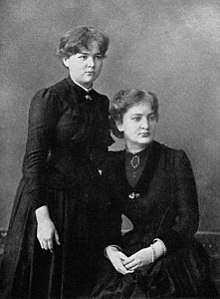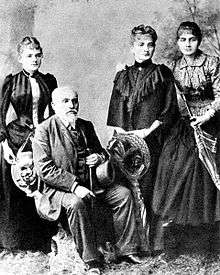Bronisława Dłuska
| Bronisława Dłuska | |
|---|---|
 Bronisława Dłuska (right) with sister Maria, ca. 1886 | |
| Born |
Bronisława Skłodowska 28 March 1865[1] Warsaw, Kingdom of Poland, then part of Russian Empire |
| Died |
15 April 1939 (aged 74) Warsaw, Second Polish Republic |
| Nationality | Polish |
| Occupation | Physician |
| Spouse(s) | Kazimierz Dłuski (1855–1930) m. 1890 |
| Children |
Helena Dłuska (1892—1922) Jakub Dłuski (c.1896/7—1903) |
| Awards |
|
| Education | University of Paris |
| Alma mater | University of Paris |
| Known for | Co-founder and first director of Maria Skłodowska-Curie Institute of Oncology, Warsaw |
| Scientific career | |
| Fields | Medicine, Oncology |
| Institutions | Maria Skłodowska-Curie Institute of Oncology |
Bronisława Dłuska ([ˌbrɔ̃ɲiˈswava ˈdwuska]; née Skłodowska, 28 March 1865[1] – 15 April 1939) was a Polish physician, and co-founder and the first director of Warsaw's Maria Skłodowska-Curie Institute of Oncology. She was married to political activist Kazimierz Dłuski, and was an older sister of physicist Marie Curie.
Biography
Early life
Bronisława was born 28 March 1865[1] in Warsaw to Władysław Skłodowski and Bronisława Skłodowska, both of whom were teachers. The second eldest of five children, she had three sisters—Zofia, Helena, and Maria—and a brother, Józef.
On both the paternal and maternal sides, the family had lost their property and fortunes through patriotic involvements in Polish national uprisings aimed at restoring Poland's independence (the most recent had been the January Uprising of 1863–65).[2] This left the subsequent generation to a difficult struggle to get ahead in life.[2]
Her paternal grandfather, Józef Skłodowski, had been a respected teacher in Lublin, where he taught the young Bolesław Prus,[3] who would become a leading figure in Polish literature.[4] Her father, Władysław Skłodowski, taught mathematics and physics, and was also director of two Warsaw gymnasia for boys.[5] After Russian authorities eliminated laboratory instruction from the Polish schools, he brought much of the laboratory equipment home, and instructed his children in its use.[5]
The father was eventually fired by his Russian supervisors for pro-Polish sentiments, and forced to take lower-paying posts; the family also lost money on a bad investment, and eventually chose to supplement their income by lodging boys in the house.[5] Her mother, Bronisława, operated a prestigious Warsaw boarding school for girls; she resigned from the position after Maria was born.[5] She died of tuberculosis in May 1878, when the young Bronisława was only 13 years old, leaving the teenager, now the eldest woman in the family, to care for Helena, Maria, and Józef.[5] Less than three years earlier, Bronisława's older sister, Zofia, had died of typhus contracted from a boarder.[5]
Education and life in Paris
In 1882 Bronisława graduated from secondary school with a gold medal. Unable to study at institutions of higher learning that did not admit women, she joined the underground Floating University, tutoring to fund her future studies. At age 19 she left for Paris, where she studied medicine at the Sorbonne.[6] Maria helped her sister financially, under an agreement that Maria would help Bronisława during her medical studies, in exchange for similar assistance when Maria went to study in Paris.[5]
In 1890 Bronisława graduated as a gynaecologist-obstetrician and married political exile and fellow physician Kazimierz Dłuski. The couple were active in the local community; she ran a medical clinic, many of her clients being workers and their families, and the couple's apartment was a "culture salon"[6] for Polish exiles, immigrants, and expatriates.[6][7]
At her sister's insistence, Maria joined the couple in Paris in 1891 to likewise study at the Sorbonne. Maria lived with them for a time before renting a garret closer to the university than the one-hour carriage ride from Bronisława's apartment.[6][7][8]
Bronisława and Kazimierz had a daughter, Helena, in 1892, then a son, Jakub, a few years later.[6][9]
Return to Poland
.jpg)
She and Kazimierz returned to Poland in 1898 to set up a pulmonological sanitarium in the southern, Tatra Mountains resort town of Zakopane. Kazimierz was not permitted to travel to the Russian partition of Poland.
Beginning in early August 1914, one of Zakopane's notable World War I visitors was the Polish-born English-language novelist Joseph Conrad, who took refuge there with his family. The patriotic Bronisława Dłuska scolded him for using his great literary talent for purposes other than bettering the future of his native Poland,[10] which Conrad had left at age 16.[11]
After World War I, Poland regained her independence, and Kazimierz joined the Polish delegates at the 1919 Versailles Peace Conference.
Now free to return to a Warsaw no longer under Russian rule, the Dłuskis set up a tuberculosis preventorium in the Warsaw suburb of Anin.[6]
Following the successful opening of the first Radium Institute in Paris in 1918, Maria, now known by her adopted French given name of Marie, began work setting up a second institute in Warsaw. Building began in 1925 with the laying of the foundation stone of the Warsaw Radium Institute, with Bronisława to be its director. She supervised the construction and recruitment, while Marie raised funds in the United States and elsewhere, and despite the death of Kazimierz in 1930, Bronisława continued to run and oversee the creation of the facility. On 29 May 1932, the Institute was officially opened, with Bronisława as the first director.[6][12]
Death

On the 15th of April 1939, Bronisława died of old age. She is buried in the family tomb with her parents, her sisters Zofia and Helena, and her brother Józef.[13]
References
- 1 2 3 Genealogia, Genealodzy.PL. "Program indeksacji aktów stanu cywilnego i metryk kościelnych". metryki.genealodzy.pl. Retrieved 17 November 2017.
- 1 2 Wierzewski, Wojciech A. (21 June 2008). "Mazowieckie korzenie Marii" [Maria's Mazowsze Roots]. Gwiazda Polarna. 100 (13): 16–17. Archived from the original on March 21, 2009. Retrieved 23 August 2015.
- ↑ Reid, Robert William (1974). Marie Curie. New American Library. p. 12. ISBN 0002115395.
- ↑ Miłosz, Czesław (1983). The History of Polish Literature. University of California Press. p. 291. ISBN 978-0-520-04477-7.
Undoubtedly the most important novelist of the period was Bolesław Prus...
- 1 2 3 4 5 6 7 "Marie Curie – Polish Girlhood (1867–1891) Part 1". American Institute of Physics. Retrieved 7 November 2011.
- 1 2 3 4 5 6 7 Podogrocka, Ewa. "Bronisława Dłuska". Unlearned Lessons. Retrieved 22 August 2015.
- 1 2 "Marie Curie – Student in Paris (1891–1897) Part 1". American Institute of Physics. Retrieved 7 November 2011.
- ↑ Robert William Reid (1974). Marie Curie. New American Library. p. 32. ISBN 0002115395.
- ↑ Sarv, Henn (3 November 2014). "Bronisława Dłuska". Geni.com. Retrieved 23 August 2015.
- ↑ Zdzisław Najder, Joseph Conrad: A Life, translated by Halina Najder, Rochester, New York, Camden House, 2007, ISBN 1-57113-347-X, p. 463.
- ↑ Zdzisław Najder, Joseph Conrad: A Life, 2007, p. 44.
- ↑ Skwarzec, Bogdan (March 2011). "Maria Skłodowska-Curie (1867–1934)—her life and discoveries" (PDF). Anal Bioanal Chem (Special issue: Radioanalytics—Dedicated to Marie Skłodowska-Curie). doi:10.1007/s00216-011-4771-3.
- ↑ "Warsaw in the footsteps of Maria Skłodowska-Curie". Warsaw Tourist Office. Retrieved 22 August 2015.
| Wikimedia Commons has media related to Bronisława Dłuska. |
